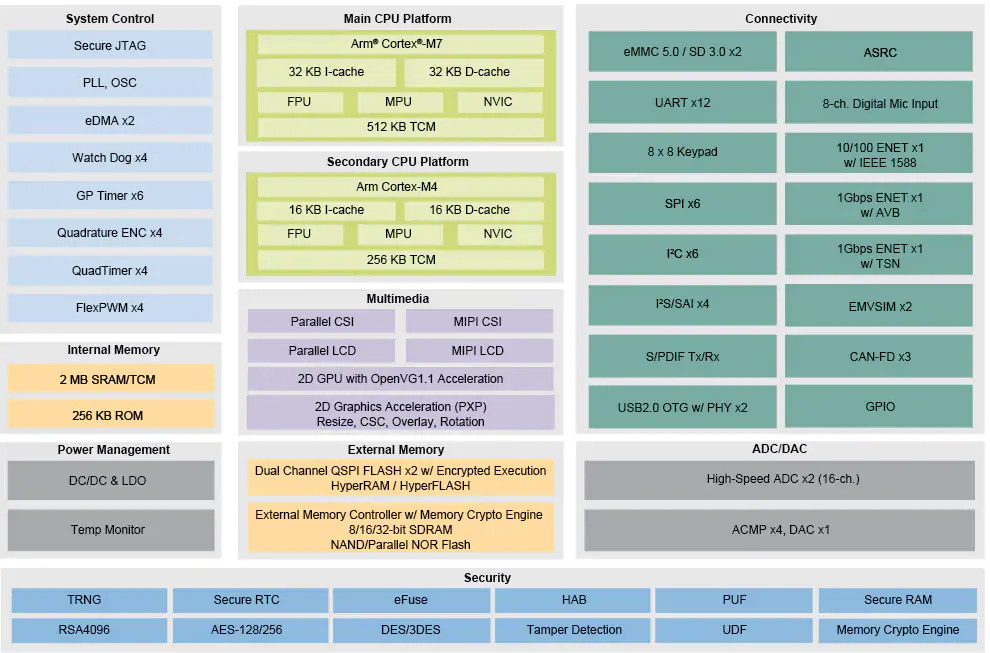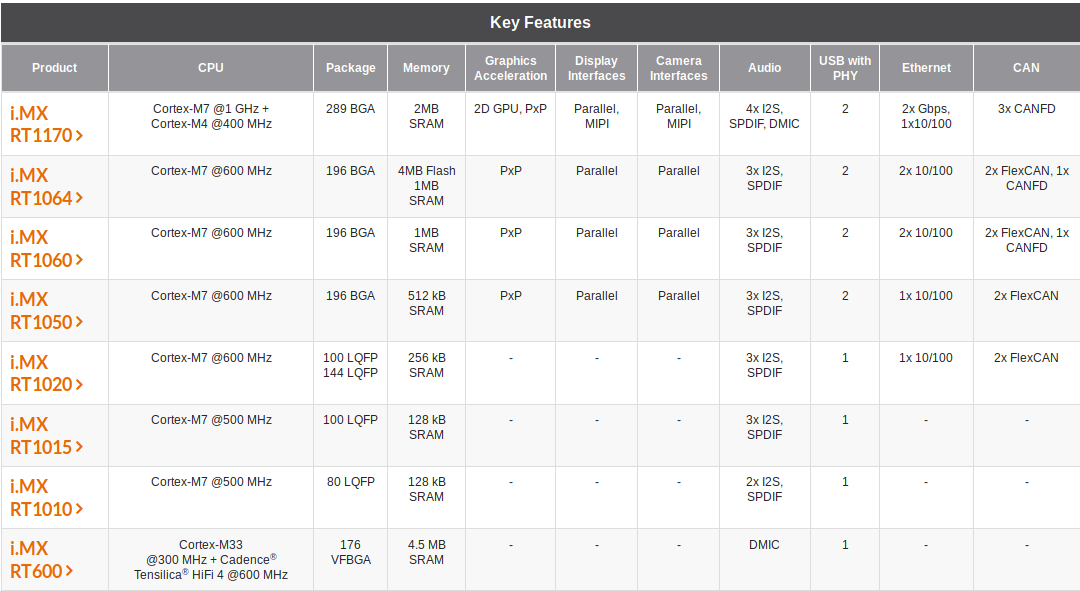Microcontrollers used to be those cute little things that clock at 8 or 16 MHz, but in the last decade, Cortex-M3/M4 microcontrollers became more powerful with 100 to 200 MHz clocks being quite common.
But with the introduction of Arm Cortex-M7 core about 5 years ago, microcontrollers are seriously starting to take over tasks that were previously reserved to faster microprocessors. As I remember it, the MCU frequency “race” started with STMicro STM32H7 in 2016 with an impressive 400 MHz, and NXP i.MX RT crossover processor clocked at 600 MHz a few years later. But with i.MX RT1170 microcontroller, NXP has upped the ante as the new MCU combines an Arm Cortex-M4 core clocked at 400MHz with Arm Cortex-M7 core running at an amazing one Gigahertz (1 GHz).

The documentation has not been released and we have limited information, but here’s what we know about NXP i.MX RT1170 key features and specifications so far:
- CPU
- Arm Cortex-M7 @ 1 GHz
- Arm Cortex-M4 @ 400 MHz
- 6468 CoreMark, 2974 DMIPS
- Graphics Accelerators – 2D GPU with OpenVG 1.1 support, PxP (pixel processing pipeline)
- Memory / Storage – Up to 512KB Tightly Coupled Memory (TCM) with ECC, 2MB SRAM
- Display I/F – Parallel and MIPI LCD up to 720p @ 60 Hz or 1080p @ 30 Hz
- Camera I/F – Parallel and MIPI CSI camera
- Audio – 4x I2S, SPDIF, DMIC
- Connectivity – 2x Gigabit Ethernet with AVB (Audio/video bridge) and TSN (Time-sensitive Networking), 1x 10/100M Ethernet
- USB – 2x USB 2.0 PHY
- Serial – 3x CANFD
- Security – EdgeLock 400A security solution, secure boot, and crypto engines
- Package – 289 BGA
- Process – 28nm FD-SOI technology
NXP i.MX RT1170 is also said to offer 12ns interrupt response time.

The new MCU/crossover process is supported by MCUXpresso SDK, IDE and configuration tools. Target applications include instrument clusters in automotive products, home appliances system control, in-home energy displays, industrial and motor control.
NXP further explains the GHz Cortex-M7 core greatly enhances machine learning performance for tasks like voice, vision and gesture recognition, natural language understanding, data analytics, and digital signal processing.
NXP i.MX RT1170 was announced at Arm Techcon 2019 and will be demonstrated at the event. The company will also showcase its sub-$1 i.MX RT1010 family and will start to offer the MIMXRT1010-EVK for $10.10 on October 10 for a limited time.
More details should eventually be posted on the product page.

Jean-Luc started CNX Software in 2010 as a part-time endeavor, before quitting his job as a software engineering manager, and starting to write daily news, and reviews full time later in 2011.
Support CNX Software! Donate via cryptocurrencies, become a Patron on Patreon, or purchase goods on Amazon or Aliexpress





The RT1010 is interesting, other MCUs with “high-speed”/480mbps USB 2.0 PHYs all seem to be $10 chips (though who knows how much of that bandwidth it can actually fill). But I wonder how much it will actually cost in real-life for hobbyist quantities.
Allwinner S3 (BGA) or R11 (QFN) have 128MB/64MB DRAM inside and USB 2.0 host/device and they are $3 parts. You can buy an S3 dev board here for about $20.
https://item.taobao.com/item.htm?spm=a1z09.2.0.0.640c2e8dRG4Kfs&id=591896289694&_u=41ml3kqt0c4f
RT1010 is less than one dollars according to NXP. I don’t know in which quantities though.
Everything at NXP is always under $1 if you buy 10,000,000 of them. Lowest real price I can find is $2.04 Q1000.
If you use SPI NOR with any of the V3 based chips you no longer have a usable SPI interface.
Chips like this: http://www.superic.com/soludetail-286.html have multiple SPI, I2C, ADC channels, memory mapped NOR etc and they are in the same price range as the V3 based chips and come in QFN not QFP (smaller, less easy to damage).
What is the state of software for the SSC328Q? Can I download the SDK somewhere?
I need an ‘invitation code’ to register.
I am open to chips like the SSC328Q but I don’t want to waste a lot of time trying to gain access to the information about them. I hate it when I spend a month messing around with salesmen, NDA, etc. Then they finally give me the user manual, I look at it for five minutes and tell them the chip won’t work in our application. Let me determine if the chip is suitable without a lot of hassle!
>What is the state of software for the SSC328Q?
If you can get a contact at the company directly there seems to be a 4.x kernel based SDK for it. MOQ is ~2080 units.
If you don’t care about the camera and video encoders I have mainline u-boot and linux for that series of chips with I think almost feature parity with the V3 based chips in mainline aside from USB and SD host needing some work to make them reliable.
Does this have an LCD controller? that may be a knockout punch. It does not appear to have h.264 decode. We can’t use it, it can’t display the recorded video. This chip only good for making a security camera.
Do you have link to datasheet? This chip very similar to Ingenics T30.
That one doesn’t have a display controller (I think it’s actually in the chip but not bonded out).
There seems to be a variant with an LCD driver for dashcams but I haven’t found anything on taobao with it in there yet.
>Do you have link to datasheet?
I have data briefs for their similar chips but not that exact one. The chips are very similar as the kernel port I did based on the old SDK boots right up all of the different variants I have so far.
>This chip very similar to Ingenics T30.
I looked at that too but passed on it because of mips being basically dead. All of the other SoCs I could find with DDR integrated were ARM9 except the allwinner v3 based ones.
The T30 is interesting because they added a SIMD coprocessor to it that can run CNN neural networks. T30 does not have LCD controller.
If you’re still interested I found someones copy of the data brief for one of the versions of the chip I mentioned that has an LCD controller here:
http://eng.pointcloud.ai/rails/active_storage/disk/eyJfcmFpbHMiOnsibWVzc2FnZSI6IkJBaEpJaDFRT1dsMlVITTFiWFpCYTNOeVVHUnlhVzVXZUdSaE5XSUdPZ1pGVkE9PSIsImV4cCI6IjIwMTktMTAtMDVUMTQ6NDQ6MzMuODkzWiIsInB1ciI6ImJsb2Jfa2V5In19–06d59640fc4e5a0dad2b2f8496448f70f86499e6/SSC8339DEW_pb_v01_%E7%82%B9%E4%BA%91.pdf?content_type=application%2Fpdf&disposition=inline%3B+filename%3D%22SSC8339DEW_pb_v01_%253F%253F.pdf%22%3B+filename%2A%3DUTF-8%27%27SSC8339DEW_pb_v01_%25E7%2582%25B9%25E4%25BA%2591.pdf
Looks like it has the video decoders you wanted too. Other than that part it’s almost a copy and paste of the rest of their chips so it’ll work with the mainline port I have and there should be a vendor 4.x based SDK for it. There seems to be a version in a 128 QFN too.
One of our people in China will talk to MSTAR/Sigmastar next week.
Can you give me a link to the SDK you have, unifore took it down.
This is an old one I based my kernel port on:
https://mega.nz/#!itcWASKR!hd5R7EsRAPlfE7y3HZBuYCPUA0ztpuxotSgVDyAlgdY
thanks, downloading it now. I just want to get general idea of what is in their SDK.
>I just want to get general idea of what is in their SDK.
u-boot is a mess, kernel is a mess.. the video part is supplied as a bunch openmax libraries that should mean it could be cleanly used with gstreamer but I never managed to get that working.
That SDK is really old though and contains a huge amount of cruft from their previous MIPS SoCs so maybe the 4.x one is better. I’ve seen firmware with a 4.x kernel so I know it’s out there somewhere. The video blocks seem to be IP they have bought in as the English comments for the registers etc are too good.
Bare chips here, note these are Q1 prices.
https://item.taobao.com/item.htm?spm=a230r.1.14.16.4ccd77davrdeda&id=578537254553&ns=1&abbucket=15#detail
Datasheet and SDK here:
https://cn.doraiot.com/bbs/topic/457/allwinner-s3-datasheet-v1-0-sochip
This is 1.2Ghz Cortex A7 chip with embedded DRAM.
This chip is fully supported in mainline except for: MIPI sensors, h.264 encode, ISP
The SDK has fully support but no source code for those pieces.
Most of that information is also available @ https://www.cnx-software.com/2018/03/30/allwinner-s3-camera-soc-includes-128mb-ram-an-i2s-audio-interface/ (See comments).
Can’t wait till they hit 1.21 jiggawatts.
Now that the Cortex-M7 has clock parity with the Cortex-A7, what is the major difference? The biggest one I can call out is the MMU which is still only on the A series. The M series can only get the less capable MPU, which means no “real” Linux, only uClinux.
Looking at NXP’s catalog for an apples-to-apples comparison, this seems to compete heavily with the i.MX 7 family. Especially the i.MX 7ULP and i.MX 7Solo variants that are single core but actually clocked slower at 800 MHz.
There’s that great big NEON unit in the A7.